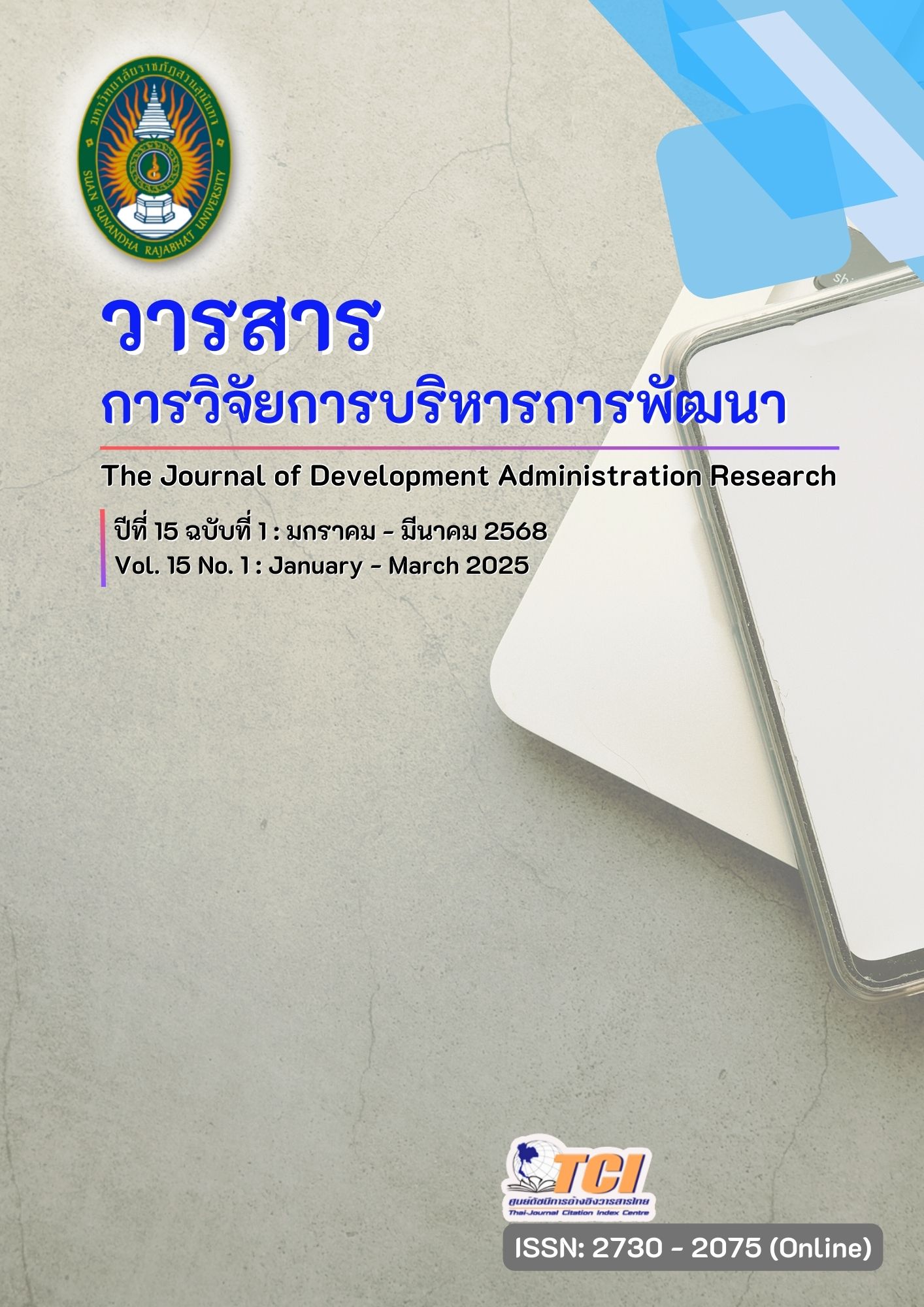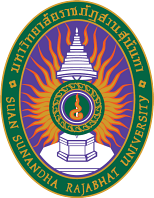Public Administration of the Digital Era and Its Effects on the Development of Livable Cities
คำสำคัญ:
Public Administration, Digital-Era, Livable Citiesบทคัดย่อ
This study aims to 1) to examine the level of development of livable cities; 2) to analyze the factors of Public Administration of the Digital Era influencing the development of livable cities; and 3) to propose digital-era public administration guidelines that contribute to the development of livable cities. Employing a mixed-methods approach, the research collected quantitative data from 400 government officials, state enterprise employees, and local administrative organization staff using a multi-stage sampling method, starting with stratified sampling by district, followed by purposive sampling of employees from local government units and state enterprises. The study also included qualitative insights from in-depth interviews, conducted using purposive sampling, with five executives from departments related to the management of local administrative organizations. The analysis utilized percentages, means, standard deviations, skewness, kurtosis, and multiple regression analysis to comprehensively assess variable relationships and model significance, and content analysis.
The findings highlight that 1) The level of livable city development in Pathum Thani Province is rated high across all five dimensions—social, economic, physical, environmental, and technological with an overall mean score of 4.03. 2) Regression analysis reveals that work skills, structure, and communication are key positive predictors across all dimensions. Leadership and organizational culture show mixed effects, with significant negative impacts in some areas. 3) The study proposes guidelines that integrate digital-era public administration practices to strengthen livable city development, offering practical insights for policymakers, public administrators, private sector stakeholders, and researchers to implement effective strategies in leveraging digital-era public administration.
เอกสารอ้างอิง
Agostino, D., Arnaboldi, M., & Lema, M. D. (2021). New development: COVID-19 as an accelerator of digital transformation in public service delivery. Public Money & Management, 41(1), 69–72.
Ahvenniemi, H., Huovila, A., Pinto-Seppä, I., & Airaksinen, M. (2017). What are the differences between sustainable and smart cities?, 60, 234-245.
Allam, Z. (2020). Seeking liveability through the Singapore model. In Urban governance and smart city planning: Lessons from Singapore. Emerald Publishing Limited.
Allam, Z., Sharifi, A., Bibri, S. E., & Chabaud, D. (2022). Emerging trends and knowledge structures of smart urban governance. Sustainability, 14(9), 5275.
Alford, J., & Head, B. W. (2017). Wicked and less wicked problems: a typology and a contingency framework. Policy and society, 36(3), 397-413.
Best, J. W. (1997). Research in education (3rd ed.). Prentice-Hall.
Bibri, S. E., & Krogstie, J. (2020). Smart sustainable cities of the future: An extensive interdisciplinary literature review. Sustainable Cities and Society, 53, 101933.
Breevaart, K., & Bakker, A. B. (2018). Daily job demands and employee work engagement: The role of daily transformational leadership behavior. Journal of Occupational Health Psychology, 23(3), 338–349.
Chen, Z. (2020). Evaluating Sustainable Liveable City via Multi‐MCDM and Hopfield Neural Network. Mathematical Problems in Engineering, 2020(1), 4189527.
Choi, I. (2016). Digital era governance: IT corporations, the state, and e Government. International Review of Public Administration, 21(4), 359–361.
Cochran, W. G. (1977). Sampling techniques (3rd ed.). Wiley.
Field, A. (2013). Discovering Statistics Using IBM SPSS Statistics (4th ed.). SAGE Publications.
Idzi, R., & Gomes, R. C. (2022). Digital governance: Government strategies that impact public services. Global Public Policy and Governance, 2(4), 427–452.
Jiang, Y., Cannella, A. A., Xia, J., & Semadeni, M. (2020). Strategic leadership in the twenty-first century: Integrating the traditional corporate strategies with changing management paradigms. Strategic Management Journal, 41(12), 2174-2199.
Maslow, A. H. (1943). A theory of human motivation. Psychological Review, 50(4), 370-396.
Neumann, O., Guenther, E., & Schoenherr, T. (2022). Digital transformation and its role in public sector organizations: Identifying critical success factors. Government Information Quarterly, 39(2), 101680.
Parsons, T. (1951). The social system. Free Press.
Pathum Thani Provincial Statistical Office. (2023). Pathum Thani provincial statistics report 2024. Retrieved from https://pathumthani.nso.go.th/reports-publications/ebook/44-2567.html
Phusit, P. (2015). Innovation, development paths, and indigenous wisdom. Bangkok: Deewit.
Roka, K. (2019). Liveable city: Towards economic, social, cultural, and environmental well-being. In W. Leal Filho, A. Marisa Azul, L. Brandli, P. Gökcin Özuyar, & T. Wall (Eds.), Sustainable cities and communities (Encyclopedia of the UN Sustainable Development Goals). Springer, Cham.
Tabachnick, B. G., & Fidell, L. S. (2013). Using Multivariate Statistics (6th ed.). Pearson.
Thailand Government Public Relations Department. (2023). Plan for driving Thailand with the BCG model, 2021-2027. Retrieved September 9, 2024, from https://www.thailand.go.th
Van Wart, M. (2014). Leadership in public organizations: An introduction. Routledge.
Viale Pereira, G., Parycek, P., Falco, E., & Kleinhans, R. (2021). Smart governance in the context of smart cities: A literature review. Information Polity, 26(3), 203–220.
World Health Organization. (2023). Thailand recognizes local governments for achieving healthy cities goals. World Health Organization. Retrieved September 9, 2024, from https://www.who.int/thailand/news/detail/28-08-2023-thailand-recognizes-local-governments-for-achieving-healthy-cities-goals
Yamane, T. (1973). Statistics: An Introductory Analysis (3rd ed.). New York, NY: Harper and Row.
ดาวน์โหลด
เผยแพร่แล้ว
รูปแบบการอ้างอิง
ฉบับ
ประเภทบทความ
สัญญาอนุญาต
ลิขสิทธิ์ (c) 2025 วารสารการวิจัยการบริหารการพัฒนา

อนุญาตภายใต้เงื่อนไข Creative Commons Attribution-NonCommercial-NoDerivatives 4.0 International License.
บทความที่ได้รับการตีพิมพ์เป็นลิขสิทธิ์ของมหาวิทยาลัยราชภัฏสวนสุนันทา
ข้อความที่ปรากฏในบทความแต่ละเรื่องในวารสารวิชาการเล่มนี้เป็นความคิดเห็นส่วนตัวของผู้เขียนแต่ละท่านไม่เกี่ยวข้องกับมหาวิทยาลัยราชภัฏสวนสุนันทา และคณาจารย์ท่านอื่นๆ ในมหาวิทยาลัยฯ แต่อย่างใด ความรับผิดชอบองค์ประกอบทั้งหมดของบทความแต่ละเรื่องเป็นของผู้เขียนแต่ละท่าน หากมีความผิดพลาดใดๆ ผู้เขียนแต่ละท่านจะรับผิดชอบบทความของตนเองแต่ผู้เดียว




